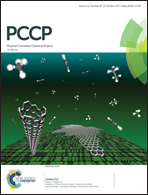Textured ZnO films from evaporation-triggered aggregation of nanocrystal dispersions and their use in solar cells†
Abstract
Due to its high electron mobility, good stability and potential for low-temperature synthesis ZnO has received considerable attention for use in solar cells, photodetectors and sensors. Whilst there have been reports involving the formation ZnO films with porous morphologies the majority of those have involved elaborate or time-consuming preparation methods. In this study we investigate a simple new method for preparing textured porous ZnO (tp-ZnO) films. We used colloidal instability triggered by the evaporation of a volatile stabilising ligand during spin-coating of a ZnO nanocrystal (NC) dispersion to deposit crack-free tp-ZnO films. The porosity of the tp-ZnO films was 56% and they could be prepared using amine-based ligands with boiling points less than or equal to 78 °C. To demonstrate the ability to use the tp-ZnO films as electron acceptors they were infiltrated with poly(3-hexylthiophene) (P3HT) and solar cells prepared. The power conversion efficiencies of the tp-ZnO/P3HT devices reached values that were three times higher than a control bilayer ZnO/P3HT device prepared using a sol–gel derived ZnO film. Because our method used a low temperature treatment and ZnO films are used in a wide variety of third-generation solar cells, the new tp-ZnO films introduced here may offer a low cost method for improving the efficiency of other solar cells.



 Please wait while we load your content...
Please wait while we load your content...